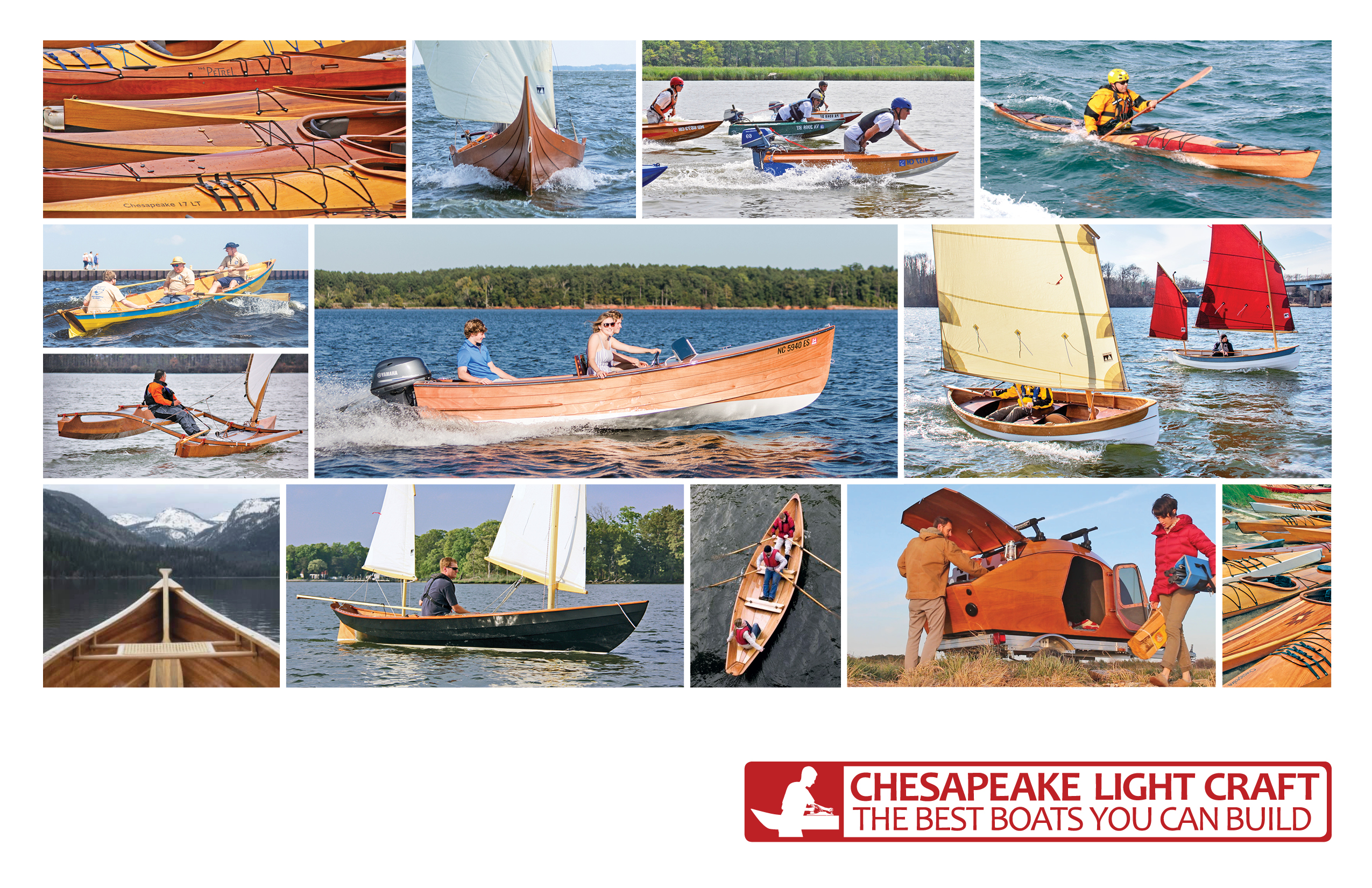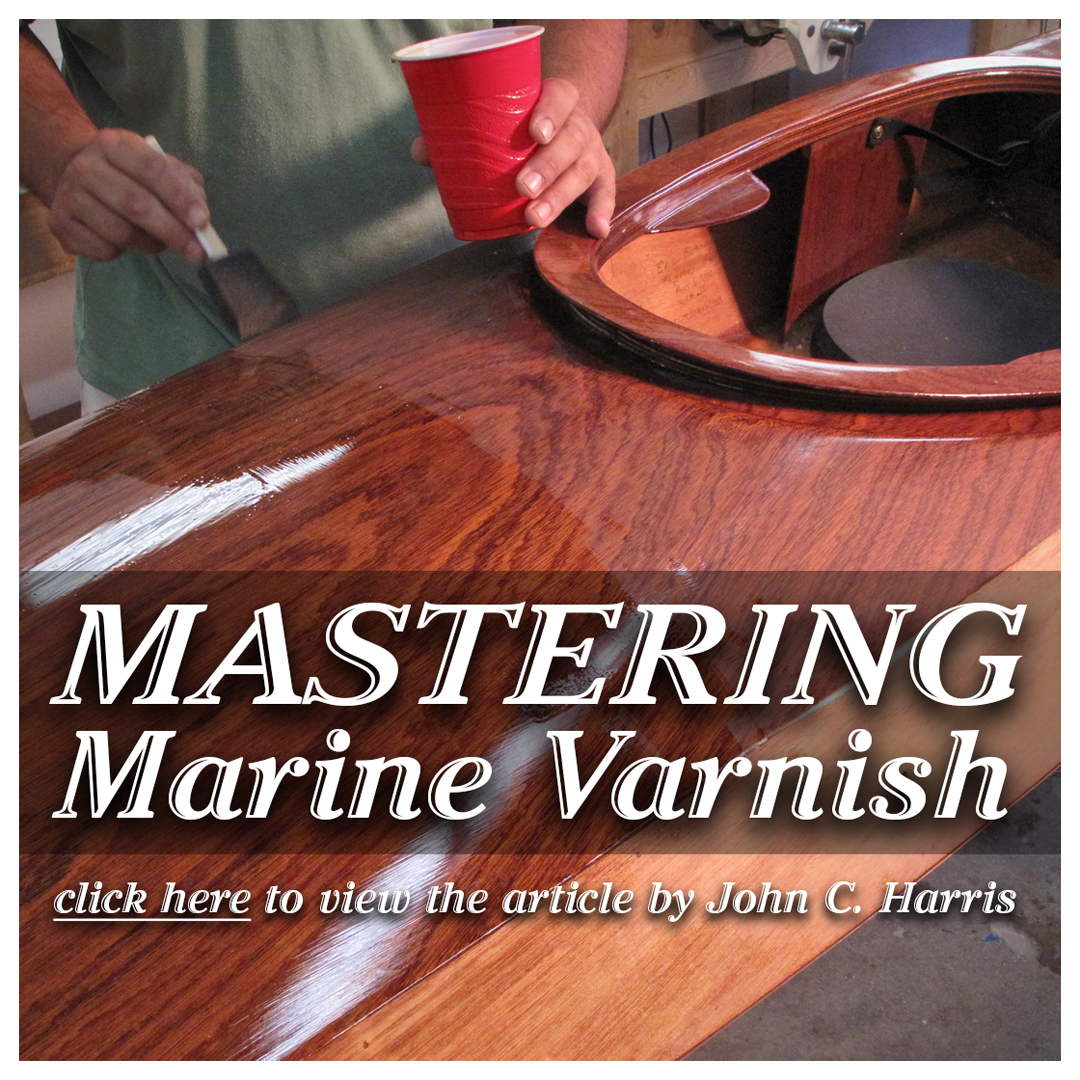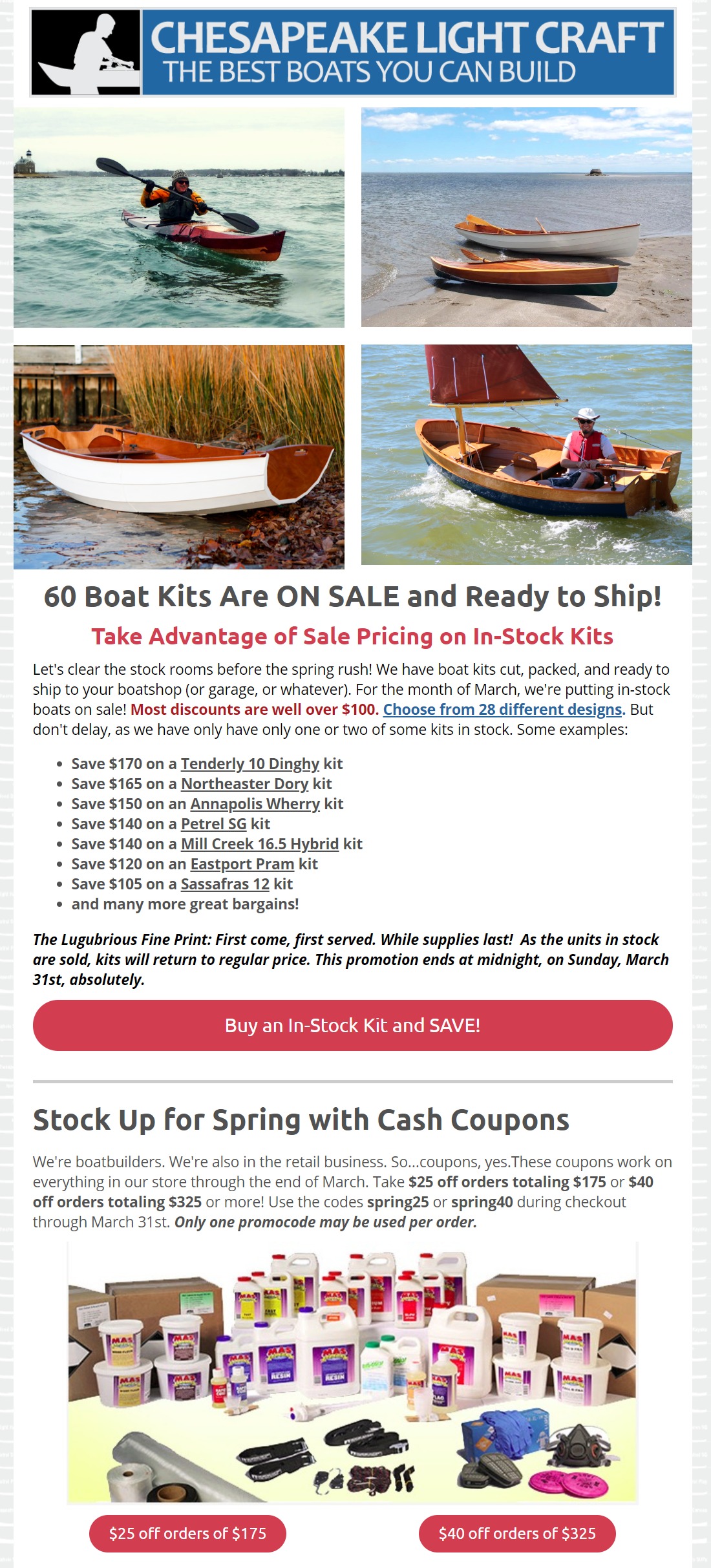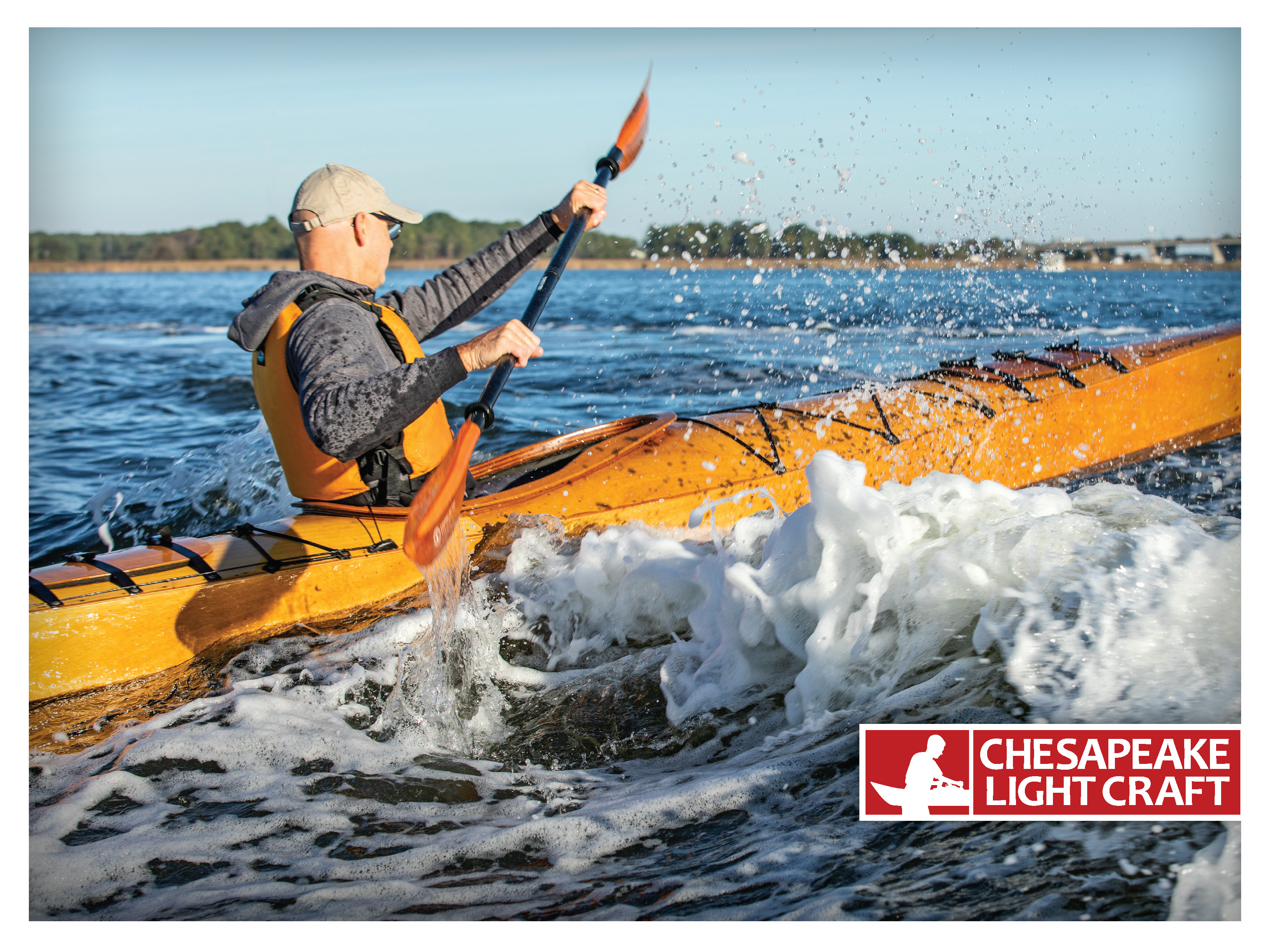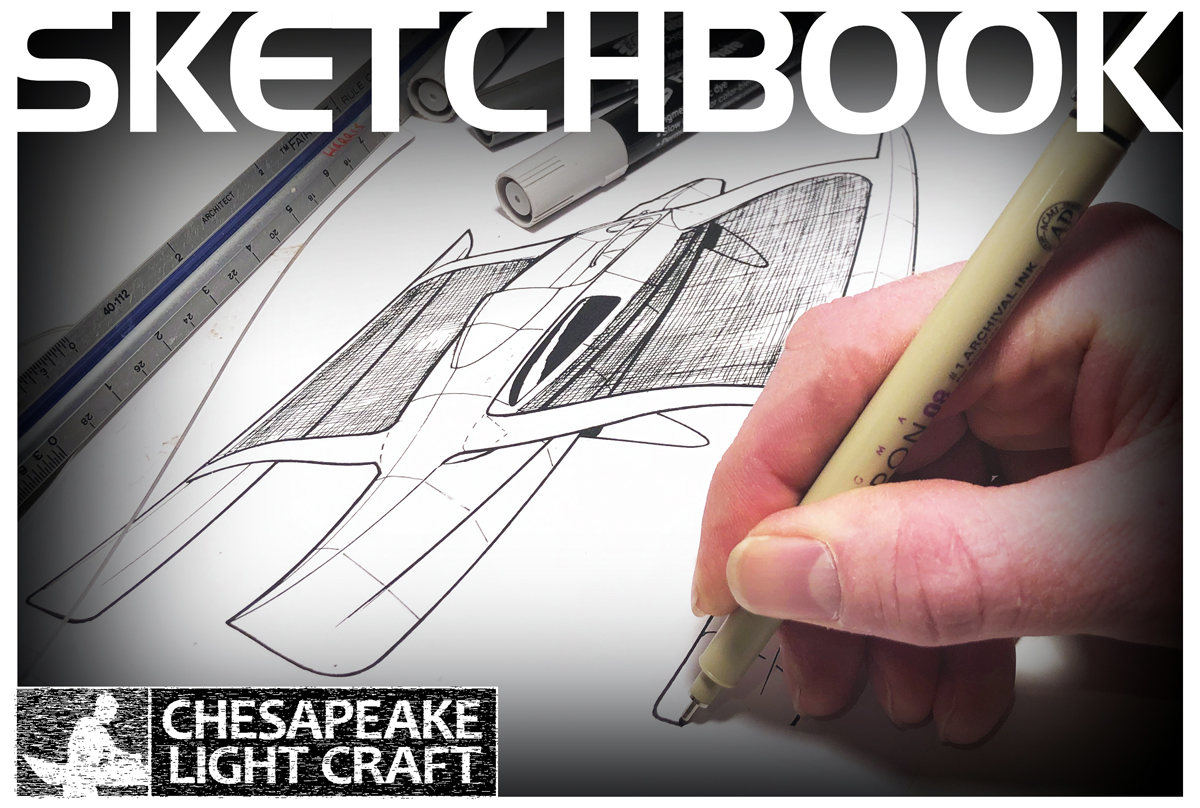
Madness Proa Main Page
By John C. Harris
October 2012
In early October, CLC's 31-foot Pacific proa Madness took a spot in the United States Sailboat Show in Annapolis, Maryland. Certainly it was the first time that a proa has ever appeared at that huge show, and in anticipation I made up some posters with "Frequently Asked Questions" to help people understand what they were looking at. In a sea of highly conventional, symmetrical white fiberglass sailboats, the asymmetrical yellow wooden proa created a lot of buzz!
What is a Pacific Proa?
A sailboat with one big hull and one little hull. The small hull (or "ama") is kept to windward at all times. This is the architecture used for thousands of years by the ocean-going peoples of the South Pacific. The reasons that proas were attractive to the South Pacific cultures are the same reasons that proas are attractive today: it's the most speed you can get for the least amount of time and materials.
Madness is a heavily Westernized and modernized version of the beach proas from Micronesia. It is built of plywood, epoxy, and fiberglass and weighs about 1400 pounds. Three have been built, of which this is the first.
Madness was designed by John C. Harris at Chesapeake Light Craft, with lots of input from Russell Brown. Brown refined the concept of the Westernized Pacific proa and has accumulated tens of thousands of sea miles in proas. The Harris design simplifies construction, but in most respects is very similar to Russell Brown's archetype: wood-epoxy composite hulls, sloop rig, and "pod" to leeward to prevent capsizes and create interior accommodations.
The purpose of this boat is to
A) Demonstrate the qualities of modernized Pacific proas
B) Serve as a technology demonstrator for Chesapeake Light Craft
C) Offer a viable and cost-effective multihull choice for amateur boatbuilders working from plans or kits
Chesapeake Light Craft (CLC) is the world's largest supplier of boat kits and supplies, with more than 45,000 kits shipped since 1993. Based in Annapolis, CLC's mission is to help people build boats. In addition to kits and plans for more than 90 award-winning kayaks, canoes, rowing boats, and sailboats, CLC is a major supplier of boatbuilding materials to amateur boatbuilders. CLC sells epoxy, fiberglass, composite materials, marine plywood, boatbuilding lumber, and specialty supplies through the mail and from an Annapolis showroom and factory.
Chesapeake Light Craft CEO and chief designer John C. Harris answers your questions:
1. This boat looks crazy. Are you mental?
Yes.
2. Seriously, what is the point?
Proas have been around for a long time, even in this hemisphere. The point is not to be weird---I can't afford to build something like this just to be weird. The point is that Pacific proas have a long list of compelling advantages. The main advantage is that, because of the asymmetry, you get to leave half the boat ashore. And the balance of forces is so perfect that the structure can be light and simple. It's the fastest boat for the money.
In terms of structural mass, Madness is about two-thirds of a trimaran or a catamaran. But it has the same righting moment. So it's incredibly fast without having to resort to a lot of carbon fiber or engineering wizardry.
3. Okay, how fast?
20 knots. I suspect Madness could work up to 22 or 23 knots in the right conditions, but I've had the boat less than a year and haven't really put the pedal down yet.
However, I designed and built Madness not as a speed machine but as a "pocket cruiser" for the Chesapeake or the Bahamas. The point wasn't to go as fast as possible, but to create a really efficient small cruiser capable of covering a lot of distance during short vacations. Getting to the Bahamas in my last boat would have been an anxious overnight adventure. In Madness it can be done in an afternoon in the right weather window.
4. Why are you here? Do you think you're going to sell these?
No. Well, not in large numbers, and then only in the form of plans or kits for home builders. There is an extremely avid community of proa enthusiasts, many of whom have been waiting for a set of plans like this for decades.
I'm here to demonstrate the technology in Chesapeake Light Craft's boat kits, and to get people thinking about proas as a legitimate alternative to a trimaran or catamaran.
At the moment, in addition to mine, four more Madness proas are nearing completion in the US. Two built professionally and two built by skilled amateurs.
5. My brain is freezing while I try to visualize how you tack and keep the little hull to windward at all times.
Yes, that happens, though only while ashore and thinking abstractly about how a proa tacks. Once you're actually out on the water, proa sailing just feels...normal. Tacking is basically a three-point turn. You bear off, loose the sheets, drop the jib, and switch the rudders. The proa is quietly hove-to while you do all this; they are the most docile boats in the world to tack. (Usually a tack is an occasion to grab a snack or a drink—an interesting contrast to a tack in a monohull with a big overlapping genoa.) You get under way on the new tack under mainsail alone, and hoist and unfurl the "new" jib at your leisure.
Yes, tacking a proa is different than what you grew up with, but remember the flip side: It's the only sailboat that can be brought instantly to a stop and reversed under perfect control.
This is usually the point when your eyes glaze over, because you're distracted by the unfamiliar geometry, and it's important to come back to the reason to build a proa in the first place: It's a cheap, lightly-loaded structure that's easy to build. 
6. Contrast a proa with a trimaran and a catamaran. I get those, but I'm foggy on the proa thing...distract me from trying to figure out how you tack...
A trimaran has three hulls, which means at least 50% more boatbuilding work than a proa. Think about the dynamic loads of a trimaran—that leeward hull getting pushed harder and harder into the seas as the wind rises. The hull has to have enough volume to manage it, and the crossbeams have to be engineering marvels to withstand the loads. A catamaran only requires two hulls, but the compression of the mast on the forward crossbeam adds a lot of engineering anxiety, especially for boats in the same speed class as Madness.
In a proa, most of the sailing loads go to the shroud lifting the outrigger. You get some mast compression, but you aren't shoving the ama through the water with the entire weight of the boat behind it. This neat balance means lighter and simpler construction all around. Thus cheaper and easier to build. It worked with dugout canoes on the atolls in Micronesia, and it works with Madness, too. I got about $80,000 worth of performance for $20,000.
7. $20,000, huh?
That's what the materials for Madness cost. About half of that was in the rig and sails. The carbon mast was scavenged cheaply from a Nacra Inter 20, but the sails and hardware are fancy. A resourceful home builder opting for the "cruising rig" could build this boat for around $12,000. [Ed. Note: 2012 numbers!]
8. What if I want one? I have to build it? What's involved?
An extensively detailed set of plans (including patterns for most parts) costs about $500. A basic kit comprising computer-cut plywood parts and plans costs around $4500. A more complete kit, including everything but rigging and finish materials, runs about $12,500. [2012 numbers.] While not intended for first-time boatbuilders, this project is within reach of patient amateurs who are familiar with epoxy and fiberglass.
You can also have one professionally built. This one was built by Mark Bayne at Sea Island Boatworks in South Carolina.
9. Describe the construction of this boat.
Madness is built using the "stitch and glue" method. In this style of construction, pre-fabricated plywood parts are assembled with temporary wire stitches, then glued permanently with epoxy. Fiberglass reinforces everything. In fact, every surface on Madness is fiberglassed on both sides, so durability is similar to a solid fiberglass boat. The plywood is functioning as a core material to a large extent. There are some stiffening stringers made of cypress. The crossbeams and the "pod" are made from bead-and-cove cedar strips with fiberglass reinforcement. It's the same pile of materials that we use in our eight-foot dinghy kit: quarter-inch plywood and thin fiberglass.
The plywood used is Okoume, which is grown on FSC-certified plantations in West Africa and made into very high-quality marine plywood in France. Okoume is extremely light. Nearly all of the plywood is 1/4" (6mm) thick.
The boat as it sits here at the show weighs about 1400 pounds, or half the weight of a Mini Cooper.
10. That's pretty light. Can I take this boat offshore?
I get a lot of questions about taking this boat offshore. I think it's something about the yellow paint—and the very deliberate nod to the multihull designs of Dick Newick—that causes certain sailors to dream of adding an acrylic bubble over the companionway and enter the OSTAR.
Madness wasn't designed for offshore work. It's not a structural thing—I fully expect Madness to be durable in nasty coastal conditions, which can of course rival anything found at sea. The issue is that the boat is quite low-slung and light, and pretty wet in waves. Unless you're a French singlehander, a week of gale conditions would probably kill you.
A seagoing version of Madness would have about twice the volume and displacement on the same length and beam—and would be twice as expensive and twice the commitment to build.
11. Needs water ballast, maybe.
Right. And the ama DOES have provision for a couple of hundred pounds of water ballast. I haven't used it yet.
12. How long would it take to build this boat?
About a year of part time work. This boat took about 1800 hours, somewhat longer because it was the prototype and has a fancy LPU finish and a "racing" rig. The second boat took somewhat less time. The actual elapsed time will vary quite a lot based on the builder's experience and the quality of the finish.
13. What about a capsize? Is the "lee pod" enough to keep you upright? Do you sail around balancing on one hull?
With the rig to leeward and the ama far to windward, Madness has an amazing amount of righting moment. I've yet to feel even close to capsizing, and you never sail with the ama out of the water. I trim the mainsheet to keep the ama just skimming the surface.
The lee pod really does its thing when the boat is moving fast, as of course you would be in conditions sufficient to create a knockdown. If you heel enough for the pod to make contact, it smacks the ama back down instantly. The pod produces its most effective righting moment from the proa's forward motion, not from actual live buoyancy, although of course there's a lot of that, too.
14. How about transport?
Remove ten bolts and Madness comes apart for trailering. It fits on a trailer that cost me about $750 brand new and can be towed easily by my six-cylinder, 3.6 liter Ford SUV. At the end of last season, I simply hitched the boat to the bumper of a car and dragged it up a sloping grass lawn on greased 2x12's (and vice versa for the launch this spring). The boat only draws about 16 inches, so it can be moored in very shallow water and beached as needed.
15. What about a folding scheme?
That adds a lot to the complexity, weight, and cost of the structure, definitely not part of the light-fast-cheap ethos of a homebuilt proa. Nor do I think it's practical to fold a proa while afloat, though someone more clever than me will eventually figure it out. There are no plans to offer folding crossbeams for Madness. A couple of friends can unbolt and pack up the boat in about a half-day.
16. What's the cabin like?
If you're used to hot and cold running water, multiple staterooms, and seating for six in the saloon, this will feel like camping.
If you're used to camping, however, Madness is luxurious compared to a tent. There are two or three berths depending on the configuration. There is room for a chemical head and a small galley. There is comfortable seating; you can wait out a gale at anchor in a snug harbor someplace. It's the perfect size for a couple or a singlehander to cover long distances in coastal waters.
17. I'd like to find out more.
Check out the Proa's webpage for more photos, videos, and discussion about proas.
18. Can I buy a set of plans or a kit?
Plans are extensively detailed, and we've shipped about a half-dozen kits so far. Look for more info on kits and plans over on the Madness 31-foot Pacific Proa page.


 return to section:
return to section: 









